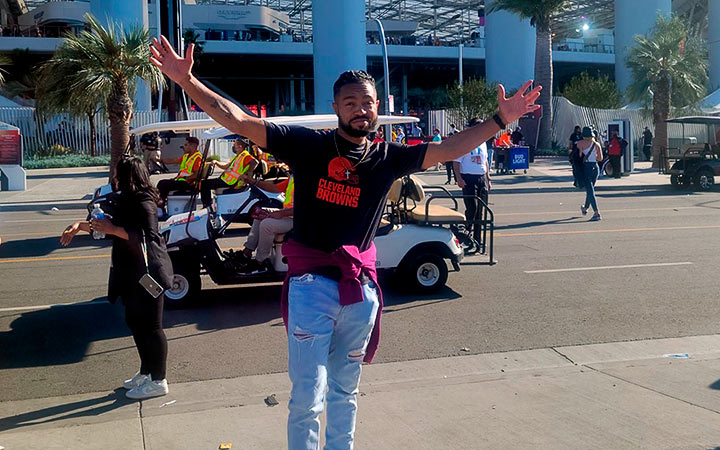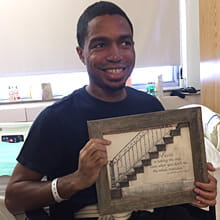Browns Player with Heart for Cardiac Patients Sends Survivor to Super Bowl
February 23, 2022

Raheem Stanfield had no idea going into cardiac arrest would be his ticket to the Super Bowl, but that’s exactly how his story unfolded.
In 2016, seconds before going into cardiac arrest after a basketball game with friends at Case Western Reserve University, Stanfield told a friend he might need an ambulance.
A passing neurosurgery resident dashed over to administer cardiopulmonary resuscitation (CPR) to the 25-year-old CWRU alumnus, the first step in a complex process of perfusing the heart until paramedics arrived to rush him to University Hospitals Cleveland Medical Center. In the few months prior, he had experienced episodes of heart palpitations that brought him to his knees, but nothing like this.
“When Raheem arrived in the Emergency Department, he did not have a pulse, but we kept pushing,” said Christopher N. Miller, MD, President of UH Clinical Network and an emergency medicine physician at UH Cleveland Medical Center. Dr. Miller and his team brought Stanfield back to life that Friday evening. “Raheem’s case perfectly illustrates the premium everyone should place on bystander CPR in the prehospital setting. If he had not received high-quality CPR prior to his arrival in the Emergency Department, he would not be alive to tell his story.”
Intensive Care
Stanfield was transferred to the Coronary Intensive Care Unit at UH Cleveland Medical Center. There, his body was cooled for 24 hours under a hypothermia protocol intended to reduce inflammation and damage to the brain brought on by the arrest. When Stanfield’s temperature was restored to normal and he woke up, doctors found left-sided weakness indicative of a stroke.
They also found that his heart looked structurally sound but were concerned about an electrical malfunction, according to Judith Mackall, MD, a cardiologist specializing in electrophysiology. Dr. Mackall implanted a defibrillator in Stanfield that would shock his heart back into rhythm in the event of another arrhythmia.
“We know that once you’re in cardiac arrest, your chance of surviving drops 10 percent for every minute you’re down,” Dr. Mackall said. “CPR keeps your vital organs perfused until you can restore heart rhythm. Raheem’s saving grace is that he had immediate initiation of CPR.”
Walking, Smiling Again
Six weeks after his cardiac arrest, Stanfield walked out of University Hospitals Parma Medical Center, following intensive inpatient therapy in the Acute Rehabilitation Unit. His parents chose UH Parma Medical Center’s highly regarded unit for its accreditation and experienced staff, despite its distance from their Cleveland home. Stanfield was making plans with his parents and three siblings for a special birthday celebration on Christmas Day. He couldn’t wait to return to his new job as a treasury specialist at Medical Mutual.
“It doesn’t matter whether you’re young or old, something can happen to you,” said Stanfield, who spent four hours each day for three weeks receiving speech, physical and occupational therapies. “All you can do is stay positive, keep working and keep fighting.”
Prior to his cardiac arrest, the only warning signs Stanfield experienced were exercise-induced asthma and heart palpitations. He had consulted a primary care physician, but an echocardiogram and cardiac event monitor worn for a period of time did not catch any of these elusive cardiac episodes.
In 2017, Stanfield recovered and started playing regular basketball games again with his friends and siblings, including several CWRU alumni. That year, he also ran two 5Ks.
A Kick in the Chest
Life continued as normal for several years until the beginning of 2021, when Stanfield was once again playing basketball with a buddy. His heart started racing and his defibrillator administered a shock to restore his heart back into normal rhythm.
“They told me if it ever went off, it would feel like getting kicked in the chest, and they were absolutely correct,” said Stanfield. “I fell to the ground. I realized what happened so I stopped playing basketball and just went home. I was grateful, because I knew I had that failsafe. And then having it go into action, it gave me more security to continue with my activities. I know it’s there and working as it’s supposed to, to protect me.”
Dr. Mackall ordered a cardiac MRI for Stanfield and discovered arrhythmogenic right ventricular cardiomyopathy (ARVC). It’s a disease of the heart muscle in which fatty fibrous tissue replaces normal heart muscle. This interrupts normal electrical signals in the heart and may cause irregular and potentially life-threatening heart rhythms especially with exercise.
In March of 2021, Stanfield received an ablation to help prevent recurrent fast heart rates.
“This was a missing piece of the puzzle. Finding out that I had this disease answered a lot of questions,” he said.
A Super Shock
Stanfield continued to do well until about a year later when he got another shock, this time, not from a defibrillator, but an NFL player who has a heart for people struggling with cardiac conditions.
The Make Them Know Your Name (MTKYN) Foundation was created by Cleveland Browns cornerback Denzel Ward. Ward’s father passed away in 2016 due to cardiac arrest. Part of the foundation’s mission is to teach CPR and spread awareness about its importance.
Ward was nominated as the Browns’ recipient for the Walter Payton Man of the Year Award in 2021 and because of that was given the opportunity to provide a fan with two Super Bowl tickets. He and the MTKYN Foundation selected Stanfield after hearing his story and how it perfectly fit the mission of the foundation.
“That was shocking. When they told me, my goal was to not completely freak out,” said Stanfield. “But it was super exciting and cool to learn about Denzel’s foundation. I want to figure out how I can be involved because the cause they’re pushing for is what saved my life.”

Coincidentally, Ward’s sister-in-law, Vanessa, was also part of the nursing team that aided in Stanfield’s recovery.
Stanfield has had many surprises, good and bad, throughout his health journey, but the most important might have been the surprise of a passing resident in the right place, willing to administer CPR at the right time.
“The reason Raheem is alive today is because of the outstanding teamwork of bystanders and prehospital providers in the field during his cardiac arrest,” said Dr. Miller. “His short-term and long-term positive outcomes are the direct result of tremendous effort and collaboration from the continuum of multidisciplinary UH providers. The Emergency Department, critical care unit, medical floor, acute rehabilitation, and Raheem’s cardiologist created this outcome for Raheem together.”


